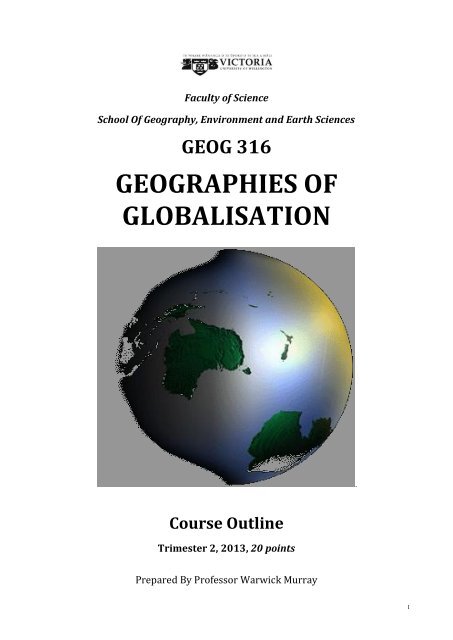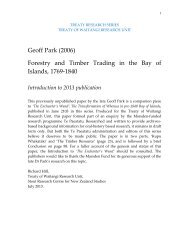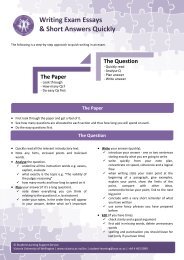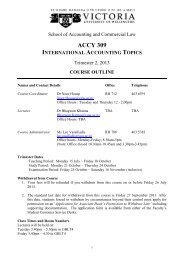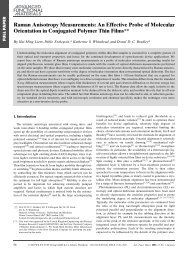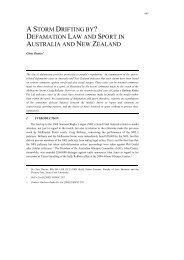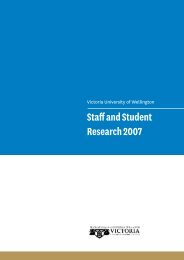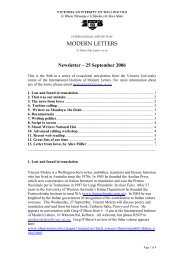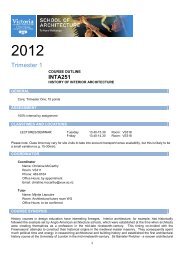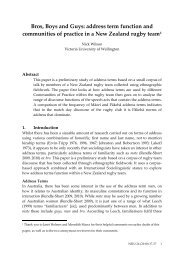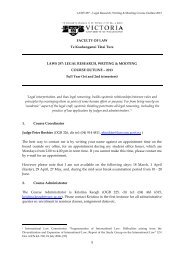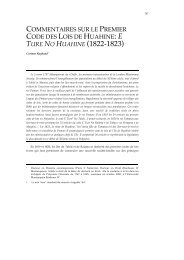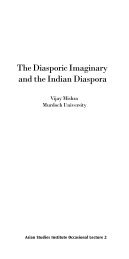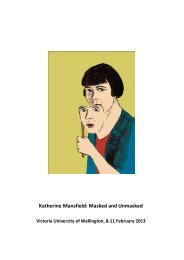Course outline 2013 - Victoria University of Wellington
Course outline 2013 - Victoria University of Wellington
Course outline 2013 - Victoria University of Wellington
You also want an ePaper? Increase the reach of your titles
YUMPU automatically turns print PDFs into web optimized ePapers that Google loves.
Faculty <strong>of</strong> ScienceSchool Of Geography, Environment and Earth SciencesGEOG 316GEOGRAPHIES OFGLOBALISATION.<strong>Course</strong> OutlineTrimester 2, <strong>2013</strong>, 20 pointsPrepared By Pr<strong>of</strong>essor Warwick Murray1
IntroductionGlobalisation is everywhere! Talked about on the TV, the radio and in newspapers it is a term that isincreasingly used to rationalise a wide range <strong>of</strong> economic and political policies, and explain a plethora<strong>of</strong> cultural, social and economic processes. Despite this, it is rarely well defined or critically appraised.A popular image <strong>of</strong> globalisation is one <strong>of</strong> a process which unfolds like a blanket across the globe,homogenising the world’s economies, societies and cultures as it falls. You will be horrified to learnthat based on this conception some have even proclaimed that Geography is dead! To the contrary,contemporary research in all sub-disciplines within geography points towards the differentiatingimpacts <strong>of</strong> global processes as they interact with local conditions. It is indeed true that the world’seconomy and culture are becoming increasingly inter-connected, but as such processes are articulatedand resisted in localities they are creating new and increasingly uneven geographies. This coursecritically engages with the concept <strong>of</strong> globalisation, examines some <strong>of</strong> its theoretical, historical, andempirical characteristics and - through case studies from ‘developed’ and ‘developing’ countries -illustrates how an appreciation <strong>of</strong> geography is fundamental to understanding globalisation.Important datesTrimester dates: 15 th July to 17 th November <strong>2013</strong>Teaching dates: 16 th July to 17 th October <strong>2013</strong>Mid-trimester break: 26 August to 9 September <strong>2013</strong>Last assessment item due: 4 th October <strong>2013</strong>Study period: 21th October to 16 th to November <strong>2013</strong>Examination/Assessment Period: 25 th October to 16 th November <strong>2013</strong>Note: students who enrol in courses with examinations must be able to attend an examination at the<strong>University</strong> at any time during the scheduled examination period.Withdrawal dates: Refer to www.victoria.ac.nz/home/admisenrol/payments/withdrawalsrefundsIf you cannot complete an assignment or sit a test or examination (aegrotats), refer towww.victoria.ac.nz/home/study/exams-and-assessments/aegrotatClass times and locationsLecture TimetableTuesday SUMT228 15:10-16.00Wednesday SUMT228 14.10-15.00Thursday SUMT228 15:10-16.00Names and contact details<strong>Course</strong> Leader - Pr<strong>of</strong>essor Warwick Murray, Coordinator <strong>of</strong> Undergraduate Geography and Director<strong>Victoria</strong> Institute for Links with Latin America, Room 211, Cotton Building, email -warwick.murray@vuw.ac.nz; Academics are researchers as well as teachers; have a look at Warwick’swork to get an idea <strong>of</strong> what he does his research and writing about – see Warwick’s Google ScholarPr<strong>of</strong>ile and his <strong>University</strong> Homepage. Warwick is also known as the Singing Pr<strong>of</strong>essor (see hisYouTube Playlist), and looks forward to hearing music from the fascinating parts <strong>of</strong> the world you allcome from!Senior tutor – Mr Pete Williams, BSc, MDevSt., Room CO104, email: peter.williams@outlook.co.nz,<strong>of</strong>fice hours to be made available during the course.Communication <strong>of</strong> additional informationAll additional information will be made available through Blackboard.2
PrescriptionAn analysis <strong>of</strong> the nature and impacts <strong>of</strong> globalisation from a geographical perspective. This coursequestions the concept <strong>of</strong> globalisation and focuses on the economic, cultural and environmentalimplications <strong>of</strong> the process in both developed and developing countries.<strong>Course</strong> contentThe course is divided into 5 themes as follows:Theme I Concepts: What in the world is globalisation?Theme II Antecedents: History and theories <strong>of</strong> globalisationTheme III Processes: Globalisation in interdependent spheresTheme IIIa: Economic globalisationTheme IIIb: Globalisation and politicsTheme IIIc: Cultural globalisationTheme IIId: Resistance to globalisationTheme IV Patterns: Geographies <strong>of</strong> globalisationTheme V Reflections: Towards what kind <strong>of</strong> world?Required Text – Murray, W. E. (2006) Geographies <strong>of</strong> Globalization, Routledge, London. Availableat Vic Books, or Amazon.com<strong>Course</strong> learning objectives (CLOs)The overall aim <strong>of</strong> this course is to introduce the skills and concepts necessary for a coherentinterpretation and critique <strong>of</strong> ‘globalisation’ from a geographical perspective. Geography is a highlyintegrative discipline. Given this, the course aims to enable a holistic and interdisciplinary reading <strong>of</strong>the multi-dimensional, rapidly-shifting, and richly-complex world <strong>of</strong> today. In this way, the materialcovered complements thematic and case study content dealt with in other Geography courses.In light <strong>of</strong> the above the course has a number <strong>of</strong> specific learning objectives. By the end <strong>of</strong> the coursestudents should be able to:1. Critically appraise contesting definitions and theories <strong>of</strong> globalisation.2. Interpret current processes <strong>of</strong> globalisation in a holistic and historical context.3. Describe and explain the main interdependent characteristics <strong>of</strong> the globalisation process inthe economic, cultural, and political spheres and <strong>outline</strong> the forces that drive these processes.4. Illustrate, through the use <strong>of</strong> appropriate case study examples, how globalisation createsuneven geographies. In particular, to be able to contrast the differentiated impacts <strong>of</strong>globalisation in the ‘developed’ and ‘developing’ world(s).5. Outline examples <strong>of</strong> how the local outcomes <strong>of</strong> globalisation are negotiated through regulationand resistance.6. Assess and communicate some <strong>of</strong> the impacts <strong>of</strong> globalisation in New Zealand through primaryfield researchTeaching FormatA detailed <strong>outline</strong> <strong>of</strong> the lectures follows below. This list is indicative only – content and timing arevery likely to change. Please attend every lecture. The chapters in the required text (Geographies<strong>of</strong> Globalization, Murray 2006, Routledge) that correspond to the lectures are noted below each week.Further reading, available from books in the library is noted under extra reading. Lecture slides will bemade available on Blackboard for you to print out on the Monday before the week <strong>of</strong> classes begins ifyou wish. Free Thinking Thursdays will <strong>of</strong>ten be a break from the normal lecture routine and willinvolve debate on critical questions stimulated by creative video, music, and/or guest speakers.3
Mandatory course requirementsIn addition to achieving an overall pass mark <strong>of</strong> 50%, students must:1. Attend the field trip.2. Attend at a minimum <strong>of</strong> 4 tutorials.WorkloadThere are 30 lectures, 5 tutorials, and a 4 hour fieldtrip (see <strong>outline</strong> <strong>of</strong> the lectures). You should expectto prepare for tutorials, and pursue readings related to lectures. There are one or two readingsassociated with each lecture which should take approximately 1½-2 hours to read. Additional work isrequired for the assignmentsAssessmentAssessment items and workload per item % CLO(s)1 Field research report 20% 1, 2, 3,5,62 Essay 40% 1,2,3,4,53 Final examination 40% 1,2,3,4,5Note: Tutorials also contribute to <strong>Course</strong> Learning Objectives 1,2,3,5,6Field research report (20%)Task – Submit a field report entitled ‘Globalisation and <strong>Wellington</strong>’Field research trip time – See timetable for course earlier in <strong>outline</strong>. Please make arrangementsnow to be free at this time. Please talk to your lecturers now if there is a clash and inform themthat this assignment is worth 20% <strong>of</strong> your total grade.Field research report purpose – The main aim <strong>of</strong> the field research project is to encourage you tothink critically about places that you might commonly encounter in <strong>Wellington</strong> and how thesehave/are being influenced by globalisation. In particular, the assertion that the ‘local’ is being erodedby global forces will be investigated in both the cultural and economic spheres. You will also beencouraged to think about <strong>Wellington</strong>’s history and links with the wider world and what this tells usabout the globalisation process in this particular locality, and in general. Aside from this, a number <strong>of</strong>practical skills including mapping, interviewing, and other human geography methods will bereinforced through the project.Context: Globalisation and <strong>Wellington</strong>The society, culture and economy <strong>of</strong> <strong>Wellington</strong> have been stronglyinfluenced by successive waves <strong>of</strong> globalisation which have washedacross the bay from increasingly far-flung lands. In very few citiesaround the world are you able to witness such clear evidenceindicating the impacts <strong>of</strong> globalisation throughout history and in different spheres (society, cultureand economy). Since the arrival <strong>of</strong> the indigenous, the establishment <strong>of</strong> a colonial trading town,independence, the pains <strong>of</strong> restructuring in the 1980s, and through until the recent opening <strong>of</strong> theMajestic Centre and Courtenay Central, the symbols and processes <strong>of</strong> globalisation have carved<strong>Wellington</strong>’s function, welfare, and character. You may not have ever thought <strong>of</strong> <strong>Wellington</strong> in these7
terms - the first aim <strong>of</strong> this short primary research project to get you to think critically about<strong>Wellington</strong>’s place in our globalising world.The forces <strong>of</strong> globalisation do not work in one direction only. The contemporary reality which hasunfolded in <strong>Wellington</strong> is indeed a partial product <strong>of</strong> the impact <strong>of</strong> globalising forces. Such forces haveinteracted with local conditions, to reconfigure economic and cultural spaces in unique ways. Everyplace is unique – although (to paraphrase George Orwell) we might argue that some places are moreunique than others. <strong>Wellington</strong> certainly has few, if any, precedents globally. This outcome is the result<strong>of</strong> the process <strong>of</strong> glocalisation. Further to this, it is also the case that there are numerous aspects <strong>of</strong><strong>Wellington</strong>’s culture/economy that have been bypassed by the forces <strong>of</strong> globalisation or have activelyresisted the process <strong>of</strong> globalisation – elements that are localised. The second major aim <strong>of</strong> thisfieldtrip is to get you to think about these three processes – globalisation, glocalisation and localisationin the context <strong>of</strong> <strong>Wellington</strong>’s cityscape and to describe, map and analyse specific examples. This formsthe core <strong>of</strong> the first task.Globalisation presents novel challenges for those who manage our urban socio-economy andenvironment. In an increasingly interconnected world, particular places are ever more vulnerable tochange beyond the nation’s borders. This was shown clearly in the restructuring impacts <strong>of</strong> the late1980s in <strong>Wellington</strong> (although <strong>Wellington</strong> did not suffer to the extent that other urban areas did – SeeMcConchie et al [eds.] 2001 for a discussion <strong>of</strong> this). This, <strong>of</strong> course is not the first time that <strong>Wellington</strong>has been thrown about on the ebbs and flows <strong>of</strong> the global economy – the Great Depression, forexample, hit the city hard. The third major aim <strong>of</strong> your research is to canvass opinion on the impacts <strong>of</strong>globalisation among the general public. In particular, for your second task you are asked to take on therole <strong>of</strong> a parliamentary candidate for <strong>Wellington</strong> in the next general election and, based partly on yourcanvassing, comment on the potential costs and benefits <strong>of</strong> globalisation for <strong>Wellington</strong>.Programme1.15pm1.30pm3.30pm3.45pm5.00pmMeet at Manners Mall outside Burger King for briefingBegin Task 1 - ‘Mapping globalisation’Meeting and group discussion in Courtenay Mall outside the Local Point Bar.Begin Task 2 - ‘Campaigning with globalisation’FinishTasksTask 1: Mapping globalisationExercise aim: To map sites <strong>of</strong> globalisation, glocalisation and localisation along your designatedroutes and to justify your categorisation.Logistics: The class will be split in two. The first group will follow a route along Manners Mall, up CubaMall and along Courtenay Place (maps will be distributed). The second group will follow a routebeginning at Lambton Quay, through Waring-Taylor Street and onto Queens Wharf. You have 2 hoursto do this exercise, including time to get to Courtenay Mall to share some <strong>of</strong> your ideas.What you have to do: You go from your start point and follow the route laid out on the map. In totalyou are required to identify 5 sites, each <strong>of</strong> which best illustrates the following in turn. Draw on atleast two economic and two cultural examples.3. globalisation4. glocalisation5. localisation6. The second wave <strong>of</strong> globalisation7. The first wave <strong>of</strong> globalisationYou should carefully locate each <strong>of</strong> these onto the sheet provided and hand it in with your write up.Spend some considerable time at each <strong>of</strong> your sites getting a feel for it and taking notes on how you8
will justify your explanation. You may wish to sketch it or photograph it (a maximum <strong>of</strong> fivephotographs can be submitted for this project however)The write up (70% <strong>of</strong> the mark for the fieldtrip report). Write a 1,000 word piece entitled ‘Culturaland economic globalisation in <strong>Wellington</strong>’ drawing from the examples you map along your route. Becareful to explain how the sites you have selected are appropriate examples <strong>of</strong> the concepts listedabove. The structure should be as follows:Brief introduction outlining concepts and ideasMiddle sections incorporating analysis <strong>of</strong> your selected sites, including any diagrams or otherillustrations you may wish to addA brief conclusion commenting on the overall process <strong>of</strong> globalisation and its impacts in thecityAt some point – it need not be at the end – you need to include your map in the write upDo not write it like a list – try to make your argument flow like a short essayCriteria for assessment: The following factors are taken into account but will not be graded formally– you will be presented with an overall mark for the piece only with general comments:StructureChoice <strong>of</strong> relevant site examplesExplanations <strong>of</strong> the choice <strong>of</strong> sitesLinking observations to wider theoretical conceptsWritten styleFlow <strong>of</strong> ideasConclusionUse <strong>of</strong> illustrations and diagrams is encouraged. A maximum <strong>of</strong> five photographs only pleaseThe inclusion <strong>of</strong> contextual material from the literature will also be looked upon favourably(see list <strong>of</strong> contextual readings on page 10)Task 2: Campaigning with globalisationExercise Aim: To get you to consider the potential costs and benefits <strong>of</strong> recent globalisation in<strong>Wellington</strong> and to communicate these as if you were a parliamentary candidate in the next generalelection.What you’ve got to do: You will need to canvass opinion in order to arrive at your statement onglobalisation as a candidate for the upcoming election. In your groups, interview a range <strong>of</strong> people (10minimum) in order to get their opinions on what the process <strong>of</strong> globalisation means for the citizens <strong>of</strong>the city. You should ask at least the following questions (include our own too):1. What do you understand by the term globalisation?2. What are the benefits <strong>of</strong> globalisation for <strong>Wellington</strong>?3. What are the costs <strong>of</strong> globalisation for <strong>Wellington</strong>?You should then attempt to incorporate the answers in the following brief written assignment:The write up: (30% <strong>of</strong> total mark for the fieldtrip assignment):You are a parliamentary candidate for <strong>Wellington</strong>. You are a bright young star and therefore wish to talkabout processes <strong>of</strong> contemporary relevance. You wish to address potential voters with your opinions onwhat globalisation means for <strong>Wellington</strong> and its citizens. In 300 words maximum <strong>outline</strong> what you feelare the main opportunities and threats <strong>of</strong> globalisation for <strong>Wellington</strong> and how you aim to minimise thelatter and maximise the former. Remember this is politics – sound bites are crucial so do not go above 300words. You must incorporate results from your recent ‘survey’ as you are a democrat. However, you may9
also incorporate your own ideas (and are likely to fudge what the public say to meet your preconceivedideas anyway!). Get into it as if you were really going to be standing.Criteria for assessment: The following factors will be taken into account but not graded separately:OriginalityWritten styleAbility to convinceAbility to be succinctVisionKey words and concepts needed for the research tasksThe concepts below will help you with the above tasks. Do not use the examples I give you below inyour write-ups please.Site: An item in which the process you are attempting to identify is visible. It may be a shop, or afinancial institution, a whole building, or statue (among other things). When identifying sites try tothink originally. For example, arguably a person is a site! A single product may also be a site. Use yourimagination if you wish.Globalisation: Greater interconnection between different parts <strong>of</strong> the globe (people, goods andservices, and places); in which increasing parts <strong>of</strong> the world are drawn into relationships whichtranscend conventional economic, political, social and cultural boundaries. Example: the diffusion <strong>of</strong>brands such as coca cola on a near global scale.Glocalisation: A blending <strong>of</strong> the local with the global (economically and culturally), the tailoring <strong>of</strong>goods (or adverts for them) to increasingly differentiated local/niche markets. Example: McDonald’sKiwi Burger.Localisation: the assertion <strong>of</strong> local characteristics, in response or resistance to globalisation. Example:The Marae in Te Papa.The first wave <strong>of</strong> globalisation: the period <strong>of</strong> global change associated with colonialism lastingbetween 1490s and 1945. Example: the street pattern <strong>of</strong> Te Aro.The second wave <strong>of</strong> globalisation: the period <strong>of</strong> global change associated with modernisation andneoliberalism. From 1945 to the present day. Example: Burger King in Lambton Quay.Contextual readingThree books may help you contextualise what you write. They are all in the library.McConchie J, Winchester D, and Willis R (eds.) (2001) Dynamic <strong>Wellington</strong>, VUW Press, <strong>Wellington</strong>Willis R (ed.) 2001 New Zealand in the 1990s, Special edition <strong>of</strong> Asia Pacific Viewpoint, April editionKelsey, J (1995) The New Zealand experiment, Auckland <strong>University</strong> press, AucklandChecklistStationary including paper and pens; something to lean on when you are writing (clipboard forexample); camera if possible; suitable shoes for a few hours walking; trendy flared trousers withoutbelt that hang around your knees, ray ban shades, and dirty trainers/sneakers to work undercover in‘crazy’ Cuba Street (optional); BFH – bus fare home.Field research report due date: Monday, September 9 th , 4pm, into GEOG 316 assignment box,level 2, Cotton Building10
Essay (40%)Task – Write a research essay <strong>of</strong> no more than 2,000 words.Aim/purpose <strong>of</strong> the essay - The essay allows you to explore in depth an area covered in lectureswhich is <strong>of</strong> particular interest to you. You must consider your subject in-depth, read as muchrelevant literature as possible, and construct an effective and convincing argument.Essay title and content – write one <strong>of</strong> the following twelve choices. Do not change the title, followthe titles below exactly:1. Assess the similarities and differences between the two historic waves <strong>of</strong> globalisation. To whatextent can it be argued that the financial crisis signifies the arrival <strong>of</strong> a third wave?2. “There will be no ‘there’ any more. We will all be here” (TV advert for telecommunicationscompany 2007). Critically assess the concept <strong>of</strong> the ‘global village’.3. Globalisation is a contested term. Compare, contrast and evaluate the definitions suggested by thefollowing schools <strong>of</strong> thought:a) Hyperglobalistb) Transformationalistc) Sceptical4. David Harvey argues that time-space compression is driven by the capitalist imperative <strong>of</strong>reducing the turnover time <strong>of</strong> capital. Does this provide a satisfactory explanation for the existence<strong>of</strong> the globalisation process? Why/why not?5. “The nation-state is becoming too small for the big problems in life, and too big for the smallproblems <strong>of</strong> life” (Daniel Bell, 2001, p. 29) Evaluate the impacts <strong>of</strong> recent globalisation on thepower <strong>of</strong> the nation-state to direct and regulate activity within its borders.6. With reference to examples from the cultural sphere discuss whether globalisation increases ordecreases geographical differentiation.7. How are new social movements shaping and being shaped by the process <strong>of</strong> globalisation? Assessthe effectiveness <strong>of</strong> the Anti-globalisation movement.8. With reference to specific case studies explore the social and economic impacts <strong>of</strong> globalisation fordeveloping countries, regions and localities.9. Distinguish between successive ‘global-scale’ divisions <strong>of</strong> labour throughout history. To whatextent is it possible to talk <strong>of</strong> a globalised economy as opposed to an internationalised economy?10. The World Bank, IMF and the WTO recommend and insist upon free-trade reform (neoliberalism).With reference to specific case studies assess the arguments for and against neoliberalism.11. Does the financial crisis <strong>of</strong> 2007-09 signal the end <strong>of</strong> neoliberal globalisation?11
Essay Referencing Style – very importantYour reference list refers to only those items that you directly refer to in the text – ie. it is not abibliography. Only 30% <strong>of</strong> your references can be internet resources. You must use reputableacademic sources to back-up what you say. Where articles from academic journals or books aredownloaded from the internet these do not count as internet sources. In this case you mustreference them as you would reference the same article in its paper form.For books:Robinson, M. (1998) My Life’s Work, <strong>Victoria</strong> <strong>University</strong> Press, <strong>Wellington</strong>.For chapters in edited books:Smith, D. and Jones, F. (1999) ‘How to reference book chapters’, in Meddows, W. and Finley, S. (eds.)Appropriate Referencing Styles, Book <strong>University</strong> Press, Librarytown, pp347-369.For articles in journals:Holy. G. (1994) ‘This is my article’, Annual Review <strong>of</strong> Interesting Articles, Vol. 21, No. 3, pp33-45.For internet references:This depends on the type <strong>of</strong> resource. Where there are specific authors assigned to the piece you arereferencing it should look as follows:Ternet, I, N. (accessed April 1993) ‘The world wide web’ Internet users online,www.internetusersonline.co.fjSometimes an internet reference may have a specific date associated with it, in this case you mustquote the date in the normal way. It may also not have an author quoted – in this case use thename <strong>of</strong> the publication or the website:Times, The (2002) ‘President Bush declared cuckoo’ The Times, April 1 st 2002, www.times.co.ukFor lecture notes:Murray, W. E. (2007) ‘A global village? Global-local interactions’, in Geographies <strong>of</strong> Globalisation Book<strong>of</strong> Lectures, pp. 145-150, Institute <strong>of</strong> Geography, <strong>Victoria</strong> <strong>University</strong> <strong>of</strong> <strong>Wellington</strong>, <strong>Wellington</strong>In-text citation:Citations should correspond to entries in your reference list, and be integrated into your written worklike this (Murray, 2006) or, for direct quotes, where “it is essential to provide a page number” (Jones,2005, p.4) you should do so. If the quote spans more than one page, indicate this (Giddens, 1999, p.15-16). The same conventions should be used where the author is an organisation (World Bank, 2004). Tocite a work with two authors, include both names (Held & McGrew, 2001, p.27), for more than twoauthors use ‘et al.’ (which means ‘and others’) after the first author’s name, like this: (Johnston et al.,2000, p.72). If your source is a website, give the name <strong>of</strong> the organisation or group to whom it belongs,not the web URL (though you would supply the address and date accessed in the reference list) – e.g.don’t cite this (http://web.worldbank.org/WBSITE/EXTERNAL/DATA/, 2007) in your essay. Forguidance check out Murray (2006) and, most importantly, try to be consistent.For further examples <strong>of</strong> referencing see the Referencite website from the <strong>University</strong> <strong>of</strong> Auckland:http://www.cite.auckland.ac.nz/index.php?p=quickcite12
Requirements for essay layout - As a general guide, your essay will be expected to include thefollowing: A cover sheet with your name, the exact title <strong>of</strong> the essay as written in this course <strong>outline</strong>, andthe course name and number on it. An introduction to the topic and <strong>outline</strong> <strong>of</strong> your essay sections – do not include a list <strong>of</strong>contents, explain the structure in prose. Relevant section headings and subheadings (where appropriate). Specific examples/case studies/figures/tables to illustrate and support the points you aremaking. An analysis or discussion <strong>of</strong> the key points. Conclusions or summary. A thorough reading list (10 items is optimal).Other points: If you go above the 2,000 word maximum you will be asked to re-submit (this maximum doesnot include references, but does include footnotes). Check that your essay includes all the components listed above. Type/write using 12pt font and 1.5 spacing, and leave a wide left-hand margin for comments. Pro<strong>of</strong> read and do a spell check.Note: In line with <strong>University</strong>, School and Institute requirements, plagiarism (copying or use <strong>of</strong> others'ideas/words without acknowledgement), and sexist or racist language or comments will not betolerated and you will gain a zero grade (see Section H).Essay Assessment Criteria - To obtain the highest grades, your essay must demonstrate: A thorough coverage <strong>of</strong> the relevant issues and debates associated with the question A deep level <strong>of</strong> understanding and analysis The use and correct integration <strong>of</strong> a wide range <strong>of</strong> readings from varied sources (no more than30% internet) A clear structure and succinct expression using examples for illustration A logical and coherent approach with a well-balanced and articulate argument Very good grammar, spelling and punctuation Pr<strong>of</strong>essionally-presented work with correctly-labelled tables and figures, integrated whereappropriate A wide-ranging and correctly-formatted reference list Originality from which the marker has learnt something new13
In line with other 300-level courses in geography the following scale <strong>of</strong> assessment is used:A+, A Outstanding Overall, the essay assignment well exceeds normal expectations <strong>of</strong> astudent at 300 level.A-, B+ Very Good Overall, the essay assignment is <strong>of</strong> a very high standard, clearlydemonstrating writing ability and thorough research. For an A-, someparts <strong>of</strong> the essay are outstanding.B, B- Good Overall, the essay assignment exceeds normal expectations <strong>of</strong> a studentat 300 level, and is generally competent showing reasonable writing andresearch skills. For a B, some parts <strong>of</strong> the essay are very good.C+, C Satisfactory Overall, the essay assignment meets normal expectations <strong>of</strong> a student at300 level, and is <strong>of</strong> an acceptable standard. Deficiencies may beapparent, but on balance, the positive aspects outweigh the negative.D Poor Overall, the essay assignment is deficient in important respects althoughreasonable effort has been demonstrated.E Unsatisfactory Overall, the essay assignment is seriously deficient in most respects andlittle effort has been demonstrated.Essay due date: 4pm, Friday October 4 th , into GEOG 316 assignment box on level 2, Geography,Cotton BuildingSummary <strong>of</strong> Assignment DeadlinesAssignmentField research reportEssayDue dateMonday, September 9 th , 4pmFriday, October 4 th , 4pmSubmission and return <strong>of</strong> workAssignmentField research reportEssayDue dateMonday, September 9 th , 4pmFriday, October 4 th , 4pmMarked assignments will be returned during tutorials.PenaltiesPenalties and Extensions for all work: Late work will be subject to a penalty <strong>of</strong> a grade (=5%) per day(a weekend = 5%). A medical certificate or other written evidence must be supplied to your tutor ifthere are circumstances <strong>of</strong> illness. This deadline cannot be extended as it is important that you getfeedback on your work before your revision period beings and that marking takes place over discreteand pre-determined periods. You have the deadlines here at the start <strong>of</strong> trimester and it is yourresponsibility to plan your time so that clashes with other assignment deadlines are workedaround.14
Field trip arrangementsSee assignment section.Set textsRequired Text – Murray, W E. (2006) Geographies <strong>of</strong> Globalization, Routledge, London. This textwas developed based on GEOG 316 and is available at the book centre. Also, Amazon.com has it. In theLecture titles table you will see the chapters that are to be read for given weeks. Warwick’s mum saysit is the best book she has ever read, apart from the phone directory.Recommended readingHand-outs – From time to time useful and interesting material will be handed out in class for you to use.Most <strong>of</strong> the resources are either in the course text, the book <strong>of</strong> lectures or the university library.Library resources – there are many books in the library which deal with globalisation. You areencouraged to use a key word search (try globalization, globalisation and global).The following two are on closed reserve:Waters, M. (2001) Globalization, 2nd ed., Routledge, LondonHeld, D., McGrew, A., Goldblatt, D. & Perraton, J. (1999) Global transformations: Politics, Economics andCulture, BlackwellsThe following books have been requested for placement on three day loan:Abdel-Gadir, F. (1998) Impact <strong>of</strong> globalization on small island states : some reflections, PIDP,Hawai’IAfshar, H. and Barrientos, S. (1999) Women, globalization and fragmentation in thedeveloping world, Macmillan, LondonAhmed, A. S. (1994) Islam, globalization, and postmodernity, Routledge, LondonBaylis, J. and Smith S. (eds.) (2005) The globalization <strong>of</strong> world politics : an introduction tointernational relations, 3 rd ed., Oxford <strong>University</strong> press, OxfordBeck, U. (2000) What is globalization?, Polity press, Malden, USABeyer, P. (1994) Religion and globalization, Sage, LondonBrah, A. et al. (1999) (eds.) Global futures : migration, environment, and globalization, StMartins Press, New YorkBulcke, D. et al. (2001) Globalization and the small open economy, Edward Elgar, CheltenhamBurbach, R. et al. (1996) Globalization and its discontents : the rise <strong>of</strong> postmodern socialism,Pluto Press, LondonCable, V. (1999) Globalization and global governance, RIIA, LondonChossudovsky, M. (2003) The globalization <strong>of</strong> poverty and the New World Order, 2 nd ed.,Global Outlook, Shanty Bay.De Souza, A. R. and Stutz, F. P. (1994) The world economy: resources, location, trade, anddevelopment Macmillan, LondonDicken, P. (1998) Global shift, PCP, LondonFeatherstone, M (1990) (ed) Global culture : nationalism, globalization and modernity, Sage,LondonFeatherstone, M. (1995) Undoing culture : globalization, postmodernism and identity, Sage,LondonHirst, P. and Thompson G. (1996) Globalization in question, Polity press, CambridgeJameson, F. (1997) (ed.) The cultures <strong>of</strong> globalization, Duke <strong>University</strong> Press, New YorkKelsey, J. (1999) New Zealand and the global economy: reclaiming the future, BridgetWilliams Books, <strong>Wellington</strong>King, A. D. (1991) Culture, globalization and the world-system, Macmillan, London.15
Knox, P. et al. (2003) The geography <strong>of</strong> the world economy, 4 th ed., Arnold, LondonKrugman, P. R. (1995) Globalization and the inequality <strong>of</strong> nations, NBER, Cambridge, USALe Heron, R. B. (1995) The Asian Pacific Rim and globalization, Avebury, AldershotMaitra, P. (1996) The globalization <strong>of</strong> capitalism in Third World countries, Praeger, WestportMassey, D. B. & Jess, P. (eds.) (1995) A Place in the world? : places, cultures and globalization,OUP Press, Milton KeynesMcGrew, A. (1992) Global politics : globalization and the nation-state, Polity Press,CambridgeMittelman, J. H. (1999) The future <strong>of</strong> globalization, Penerbit, Bangi, MalaysiaNederveen Pieterse, J. (1993) Globalization as hybridization, ISS, The HagueNederveen Pieterse, J. (ed.) (2000) Global futures : shaping globalization, Zed Press, LondonO'Meara, P. et al. (eds) (2000) Globalization and the challenges <strong>of</strong> a new century : a reader,Indiana <strong>University</strong> Press, BloomingtonSassen, S. (1994) Cities in a world economy, Pine forge press, CaliforniaScholte, J. A. (2005) Globalization : a critical introduction, 2 nd ed., Palgrave Macmillan, NewYorkScott, A. (ed.) (1997) The Limits <strong>of</strong> globalization : cases and arguments, Routledge, LondonStarr, A. (2000) Naming the enemy : anti-corporate movements confront globalisation, Zed,LondonWilliamson, J. G. (1995) Globalization, convergence, and history, NBER, Cambridge, USAWilliamson, J. G. (1996) Globalization and inequality then and now: the late 19 th and 20 thcenturies compared, NBER, Cambridge, USA.The following are highly recommended articles and chapters (search through google scholar):Adams, W. (2005) 'Sustainability' in Cloke, P., Crang, P. and Goodwin, M., Introducinghuman geographies, 2 nd ed., Hodder Arnold, London, pp. 285-297.Amin, S. (1997) ‘The capitalist economic management <strong>of</strong> the crisis <strong>of</strong> contemporarysociety’, in Capitalism in the age <strong>of</strong> globalization, Zed Press, London, pp. 12-45.Castells, M. (1997) Excerpt from The Power <strong>of</strong> Identity, Blackwell, Oxford, pp. 51-59.Chossudovsky, M. (1997) ‘The globalization <strong>of</strong> poverty’ in The globalization <strong>of</strong> poverty: Theimpacts <strong>of</strong> IMF and World Bank reforms, Pluto Press, Sydney & Zed Press, London. Pp.33-44.Crang, P. (2005) ‘Local-Global’ in Cloke, P. Crang, P. and Goodwin, M. (eds.) IntroducingHuman Geographies, 2 nd ed., Hodder Arnold, London, pp. 34-50.Dicken, P. (1998) ‘A Brief historical perspective’, in Global Shift: Transforming the WorldEconomy, 3 rd ed., Paul Chapman, London, pp. 19-23.Dicken, P. (1998) ‘The state is dead… long live the state’ in Global Shift: Transforming theWorld Economy, 3 rd ed., Paul Chapman, London, pp. 19-23.Dietz, J. L. (1995) ‘A brief economic history’, in J. L. Dietz (ed.) Latin America’s EconomicDevelopment: Confronting Crisis, 2 nd ed., Rienner, London, pp. 3-20.Held, D., McGrew, A., Goldblatt, D. & Perraton, J. (1999) ‘Catastrophe in the making:Globalization and the environment’, in Global transformations: Politics, Economics andCulture, Blackwell, Oxford, pp. 376-413.Held, D., McGrew, A., Goldblatt, D. & Perraton, J. (1999) ‘Introduction’, in Globaltransformations: Politics, Economics and Culture, Blackwell, Oxford, pp. 1-28.Holly, B. (1996) ‘Restructuring the production system’ in Daniels, P. W. and Lever, W. F.(eds.) The Global Economy in Transition, Longman, Harlow, pp. 24-39.Kiely, R. (1998) ‘Introduction: Globalisation, (post-)modernity and the Third World’ inKiely, R. and Marfleet, P. (eds.) Globalisation and the Third World, Routledge, London,pp. 1-22.Leyshon, A. (1995) ‘Annihilating Space? The speed up <strong>of</strong> communications’ in Allen, J. andHamnett, C. (ed.) A Shrinking World? Global Uneveness and Inequality, Oxford<strong>University</strong> Press, Oxford, pp. 11-54.16
Massey, D. (1996) ‘A global sense <strong>of</strong> place, in S Daniels and R Lee (eds.) Exploring HumanGeography: A Reader, Arnold, London, pp.237-245.McMichael, P. (2004) ‘The globalization project (1980s-)’ in Development and SocialChange: a Global Perspective, 3 rd ed., Pine Forge Press, London, pp. 152-200.Murray, W. E. (1998) 'The Globalisation <strong>of</strong> Fruit, Neoliberalism and the Question <strong>of</strong>Sustainability - Lessons from Chile', European Journal <strong>of</strong> Development Research, vol.10, no. 1, June, pp. 201-227.Murray, W. E. (1999) ‘Local Responses to Global Change in the Chilean Fruit Complex’,European Review <strong>of</strong> Latin American and Caribbean Studies, vol. 66, pp. 19-38.(available on library interloan).Murray, W. E. (1999) ‘Natural Resources, the Global Economy and Sustainability’ – Chapter6 in Gwynne, R., and Kay, C. (eds.) Latin America Transformed, Edward Arnold,London, pp. 128-152.Murray, W. E. (2000) ‘Neoliberal Globalisation, ‘Exotic’ Agro-Exports and Local Change inthe Pacific Islands: A Study <strong>of</strong> the Fijian Kava Sector’, Singapore Journal <strong>of</strong> TropicalGeography, vol. 21(3), pp. 33-47.Murray, W. E. (2001) ‘The Second Wave <strong>of</strong> Globalisation and Agrarian Change in the PacificIslands’, Journal <strong>of</strong> Rural Studies, volume 17/2, pp. 135-148.Poon, J. P. H. and Perry M. (1999) ‘The Asian economic flu: A geography <strong>of</strong> crisis’,Pr<strong>of</strong>essional Geographer, vol. 29, no. 2, pp. 184-196.Roberts, S. M. (2002) ‘Global regulation and trans-state organization’, in Johnston, R.,Taylor, P. and Watts, M. (eds.) Geographies <strong>of</strong> Global Change: Remapping the world,Blackwells, Malden, pp. 143-157.Smith, N. (2000) ‘Global Seattle’, Environment and Planning D: Society and Space, Vol. 18,no. 1, pp. 1-5. (available on library interloan only)Taylor, P. J. & Flint, C. (1993) ‘Geography <strong>of</strong> Imperialisms’ in Taylor, P. J. and Flint, C.Political Geography: World Economy, Nation State and Locality, 3 rd ed., Longman,Harlow, pp. 103-143.The Economist (1999) ‘The real losers’, December 11, p. 13.Tickell, A. (2005) ‘Money and finance’, in Cloke, P. Crang, P. and Goodwin, M. (eds.)Introducing Human Geographies, 2 nd ed., Hodder Arnold, London, pp. 244-252.Wartho, R. and Overton, J. (1999) ‘The Pacific Islands in the World’, in Overton, J. andScheyvens, R. (eds.), Strategies for Sustainable Development: Experience from thePacific. Zed Books, London. pp 227-240.Waters, M. (2001) ‘A world <strong>of</strong> difference’, in Globalization, 2 nd ed., Routledge, London andNew York, pp. 1-25.Waters, M. (2001) ‘New world chaos: globalizing cultures’, in Globalization, 2 nd ed.,Routledge, London and New York, pp. 182-209.Whatmore, S. (2002) ‘From Farming to Agribusiness: Global agri-food networks’ inJohnston, R., Taylor, P. and Watts, M. (eds.) Geographies <strong>of</strong> Global Change: Remappingthe world, Blackwells, Malden, pp. 57-67.Wright, R. (2002) ‘Transnational corporations and global divisions <strong>of</strong> labour’, in Johnston,R., Taylor, P., & Watts, M. Geographies <strong>of</strong> Global Change: Remapping the world,Blackwells, Malden, pp. 68-77.Journals – Since globalisation is an interdisciplinary concept you will find articles in many journals. Insearching the journals it is probably wise to look no further back than 1990. The following will beparticularly useful: Progress in Human Geography, Economic Geography, Pr<strong>of</strong>essional Geographer,Singapore Journal <strong>of</strong> Tropical Geography, Development and Change, World Development, ThirdWorld Quarterly, Economic Development and Cultural Change, The Economist, The NewInternationalist, Area, Transactions <strong>of</strong> the Institute <strong>of</strong> British Geographers, Journal <strong>of</strong> Rural Studies,Environment and Planning A, Environment and Planning D, International Journal <strong>of</strong> Urban andRegional Research, Antipode, Geographical Journal, Asia Pacific Viewpoint.17
To search most effectively for journal articles go to the library’s online resources catalogue and use theInternational Bibliography <strong>of</strong> Social Sciences (ask a librarian to show you how) or the JournalFinder.Websites – There are thousands <strong>of</strong> websites which deal with globalisation and, as with the internet ingeneral, it is <strong>of</strong>ten difficult to know where to start. Try these to start with but search yourselvesotherwise.The international forum on globalization - http://www.ifg.org/The World Bank’s view - http://www1.worldbank.org/economicpolicy/globalization/The North South Institute (for inequality and development) - http://www.nsi-ins.ca/Leverhulme globalisation research http://www.nottingham.ac.uk/economics/leverhulme/IDS globalisation research (very good) - http://www.ids.ac.uk/ids/global/Warwick <strong>University</strong> globalisation research - http://www.warwick.ac.uk/csgr/Globalisation guide - http://www.globalisationguide.org/Human rights-based globalisation - http://www.realizingrights.org/Globalise Resistance (resistance movement) - http://www.resist.org.uk/Oneworld (resistance movement) – http://www.oneworld.netCorpwatch (corporate watch dog) - http://www.corpwatch.org/Global Research Centre - http://globalresearch.ca/Class representativeThe class representative provides a useful way to communicate feedback to the teaching staff duringthe course. A class representative will be selected at the first lecture <strong>of</strong> the course. Students may liketo write the Class Rep’s name and details in this box:Class Rep name and contact details:Student feedbackStudent feedback on <strong>University</strong> courses may be found atwww.cad.vuw.ac.nz/feedback/feedback_display.php.Special needs, problems and grievance proceduresStudents should familiarise themselves with the <strong>University</strong>'s policies and statutes, particularly thoseregarding assessment and course <strong>of</strong> study requirements, and formal academic grievance procedurescontained in the statutes in the VUW website.The <strong>University</strong> Statute on Student Conduct and Policy on Staff ConductThe Statute on Student Conduct together with the Policy on Staff Conduct ensure that members <strong>of</strong> the<strong>University</strong> community are able to work, learn, study and participate in the academic and social aspects<strong>of</strong> the <strong>University</strong>'s life in an atmosphere <strong>of</strong> safety and respect. The Statute on Student Conductcontains information on what conduct is prohibited and what steps can be taken if there is acomplaint. For queries about complaint procedures under the Statute on Student Conduct, contact theFacilitator and Disputes Advisor. This Statute is available in the Faculty Student Administration Officeor on the website at:www.vuw.ac.nz/policy/StudentConduct.The policy on Staff Conduct can be found on the VUW website at:www.vuw.ac.nz/policy/StaffConduct.18
Academic GrievancesIf you have any academic problems with your paper you should talk to the tutor or lecturer concernedor, if you are not satisfied with the result <strong>of</strong> that meeting, see the Head <strong>of</strong> School or the Associate Dean(Students) <strong>of</strong> your Faculty. Class representatives are available to assist you with this process. If, aftertrying the above channels, you are still unsatisfied, formal grievance procedures can be invoked. Theseare set out in the Academic Grievances Statute which is published on the VUW website:www.vuw.ac.nz/policy/AcademicGrievances.Plagiarism (see also section c)<strong>Victoria</strong> <strong>University</strong> defines plagiarism as the copying <strong>of</strong> ideas, organisation, wording or anything elsefrom another source without appropriate reference or acknowledgement so that it appears to be one’sown work. This includes published and unpublished work, the Internet and the work <strong>of</strong> other studentsand staff. Plagiarism is an example <strong>of</strong> misconduct in the Statute <strong>of</strong> Student Conduct. Students who haveplagiarised are subject to a range <strong>of</strong> penalties under the Statute. See the website:www.vuw.ac.nz/policy/StudentConduct.Reasonable Accommodation PolicyThe <strong>University</strong> has a policy <strong>of</strong> reasonable accommodation <strong>of</strong> the needs <strong>of</strong> students with disabilities.The policy aims to give students with disabilities an equal opportunity with all other students todemonstrate their abilities. If you have a disability, impairment or chronic medical condition(temporary, permanent or recurring) that may impact on your ability to participate, learn and/orachieve in lectures and tutorials or in meeting the course requirements, then please contact the<strong>Course</strong> Coordinator as early in the course as possible. Alternatively you may wish to approach aStudent Adviser from Disability Support Services to confidentially discuss your individual needs andthe options and support that are available. Disability Support Services are located on Level 1, RobertStout Building, or phoning 463-6070, email: disability@vuw.ac.nz. The name <strong>of</strong> your School’sDisability Liaison Person can be obtained from the Administrative Assistant or the School Prospectus.Withdrawal from the <strong>Course</strong> - If you decide, for whatever reason, not to continue with the course,please come and see Warwick Murray before you do so.PlagiarismWhat is Plagiarism and Why is it Important?At university, we are continually engaged with other people's ideas: we read them in texts, hear themin lecture, discuss them in class, and incorporate them into our own writing. As a result, it is veryimportant that we give credit where it is due. Plagiarism is using others' ideas and words withoutclearly acknowledging the source <strong>of</strong> that information.How Can Students Avoid Plagiarism?To avoid plagiarism, you must give credit whenever you use another person's idea, opinion, or theory; any facts, statistics, graphs, drawings--any pieces <strong>of</strong> information--that are not commonknowledge; quotations <strong>of</strong> another person's actual spoken or written words; or paraphrase <strong>of</strong> another person's spoken or written words.How to Recognise Unacceptable and Acceptable ParaphrasesHere's the ORIGINAL text, from page 1 <strong>of</strong> Lizzie Borden: A Case Book <strong>of</strong> Family and Crime in the 1890sby Joyce Williams et al.:The rise <strong>of</strong> industry, the growth <strong>of</strong> cities, and the expansion <strong>of</strong> the population were the three great19
developments <strong>of</strong> late nineteenth century American history. As new, larger, steam-powered factoriesbecame a feature <strong>of</strong> the American landscape in the East, they transformed farm hands into industriallaborers, and provided jobs for a rising tide <strong>of</strong> immigrants. With industry came urbanization thegrowth <strong>of</strong> large cities (like Fall River, Massachusetts, where the Bordens lived) which became thecenters <strong>of</strong> production as well as <strong>of</strong> commerce and trade.Here's an UNACCEPTABLE paraphrase that is plagiarism:The increase <strong>of</strong> industry, the growth <strong>of</strong> cities, and the explosion <strong>of</strong> the population were three largefactors <strong>of</strong> nineteenth century America. As steam-driven companies became more visible in the easternpart <strong>of</strong> the country, they changed farm hands into factory workers and provided jobs for the largewave <strong>of</strong> immigrants. With industry came the growth <strong>of</strong> large cities like Fall River where the Bordenslived which turned into centers <strong>of</strong> commerce and trade as well as production.What makes this passage plagiarism?The preceding passage is considered plagiarism for two reasons: the writer has only changed around a few words and phrases, or changed the order <strong>of</strong> theoriginal's sentences. the writer has failed to cite a source for any <strong>of</strong> the ideas or facts.If you do either or both <strong>of</strong> these things, you are plagiarising.NOTE: This paragraph is also problematic because it changes the sense <strong>of</strong> several sentences (forexample, "steam-driven companies" in sentence two misses the original's emphasis on factories).Here's an ACCEPTABLE paraphrase:Fall River, where the Borden family lived, was typical <strong>of</strong> northeastern industrial cities <strong>of</strong> thenineteenth century. Steam-powered production had shifted labor from agriculture to manufacturing,and as immigrants arrived in the US, they found work in these new factories. As a result, populationsgrew, and large urban areas arose. Fall River was one <strong>of</strong> these manufacturing and commercial centers(Williams 1).Why is this passage acceptable?This is acceptable paraphrasing because the writer: accurately relays the information in the originaluses her own words. lets her reader know the source <strong>of</strong> her information.Here's an example <strong>of</strong> quotation and paraphrase used together, which is also ACCEPTABLE:Fall River, where the Borden family lived, was typical <strong>of</strong> northeastern industrial cities <strong>of</strong> thenineteenth century. As steam-powered production shifted labor from agriculture to manufacturing,the demand for workers "transformed farm hands into factory workers," and created jobs forimmigrants. In turn, growing populations increased the size <strong>of</strong> urban areas. Fall River was one <strong>of</strong> thesemanufacturing hubs that were also "centers <strong>of</strong> commerce and trade" (Williams 1)Why is this passage acceptable?This is acceptable paraphrasing because the writer: records the information in the original passage accurately. gives credit for the ideas in this passage. indicated which part is taken directly from his/her source by putting the passage in quotationmarks and citing the page number.Note that if the writer had used these phrases or sentences in his/her own paper without puttingquotation marks around them, he/she would be PLAGIARISING. Using another person's phrases orsentences without putting quotation marks around them is considered plagiarism EVEN IF THEWRITER CITES IN HIS/HER OWN TEXT THE SOURCE OF THE PHRASES OR SENTENCES SHE HASQUOTED.20
Plagiarism and the World Wide WebThe World Wide Web has become a more popular source <strong>of</strong> information for student papers, and manyquestions have arisen about how to avoid plagiarising these sources. In most cases, the same rulesapply as to a printed source: when a writer must refer to ideas or quote from a WWW site, she mustcite that source.If a writer wants to use visual information from a WWW site, many <strong>of</strong> the same rules apply. Copyingvisual information or graphics from a WWW site (or from a printed source) is very similar to quotinginformation, and the source <strong>of</strong> the visual information or graphic must be cited. These rules also applyto other uses <strong>of</strong> textual or visual information from WWW sites; for example, if a student is constructinga web page as a class project, and copies graphics or visual information from other sites, he/she mustalso provide information about the source <strong>of</strong> this information. In this case, it might be a good idea toobtain permission from the WWW site's owner before using the graphics.Strategies for Avoiding Plagiarism1. Put in quotations everything that comes directly from the text especially when taking notes.2. Paraphrase, but be sure you are not just rearranging or replacing a few words.Instead, read over what you want to paraphrase carefully; cover up the text with yourhand, or close the text so you can't see any <strong>of</strong> it (and so aren't tempted to use the text asa "guide"). Write out the idea in your own words without peeking.3. Check your paraphrase against the original text to be sure you have not accidentally used the samephrases or words, and that the information is accurate.Terms You Need to Know (or What is Common Knowledge?)Common knowledge: facts that can be found in numerous places and are likely to be known by a lot<strong>of</strong> people.Example: John F. Kennedy was elected President <strong>of</strong> the United States in 1960.This is generally known information. You do not need to document this fact.However, you must document facts that are not generally known and ideas that interpret facts.Example: According the American Family Leave Coalition's new book, Family Issuesand Congress, President Bush's relationship with Congress has hindered family leavelegislation (6).The idea that "Bush's relationship with Congress has hindered family leave legislation"is not a fact but an interpretation; consequently, you need to cite your source.Quotation: using someone's words. When you quote, place the passage you are usingin quotation marks, and document the source according to a standard documentationstyle.Paraphrase: using someone's ideas, but putting them in your own words. This isprobably the skill you will use most when incorporating sources into your writing.Although you use your own words to paraphrase, you must still acknowledge thesource <strong>of</strong> the information.Produced by Writing Tutorial Services, Indiana <strong>University</strong>, Bloomington, INOther important informationThe information above is specific to this course. There is other important information that studentsmust familiarise themselves with, including:Academic Integrity and Plagiarism: www.victoria.ac.nz/home/study/plagiarism21
Aegrotats: www.victoria.ac.nz/home/study/exams-and-assessments/aegrotatAcademic Progress: www.victoria.ac.nz/home/study/academic-progress (includingrestrictions and non-engagement)Dates and deadlines: www.victoria.ac.nz/home/study/datesGrades: www.victoria.ac.nz/home/study/exams-and-assessments/gradesResolving academic issues:www.victoria.ac.nz/home/about/avcacademic/publications2#grievancesSpecial passes: www.victoria.ac.nz/home/about/avcacademic/publications2#specialpassStatutes and policies including the Student Conduct Statute:www.victoria.ac.nz/home/about/policyStudent support: www.victoria.ac.nz/home/viclife/studentserviceStudents with disabilities: www.victoria.ac.nz/st_services/disabilityStudent Charter: www.victoria.ac.nz/home/viclife/student-charterStudent Contract: www.victoria.ac.nz/home/admisenrol/enrol/studentcontractTurnitin: www.cad.vuw.ac.nz/wiki/index.php/Turnitin<strong>University</strong> structure: www.victoria.ac.nz/home/aboutVUWSA: www.vuwsa.org.nzYou’ve got the whole world in your hands! - Warwick22


